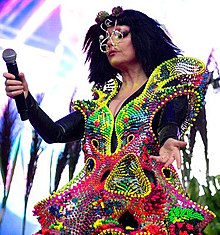Portal:Iceland
The Iceland Portal
Iceland (Icelandic: Ísland, pronounced [ˈistlant] ⓘ) is a Nordic island country between the North Atlantic and Arctic Oceans, on the Mid-Atlantic Ridge between North America and Europe. It is culturally and politically linked with Europe and is the region's westernmost and most sparsely populated country. Its capital and largest city is Reykjavík, which is home to about 36% of the country's roughly 380,000 residents (excluding nearby towns/suburbs, which are separate municipalities). The official language of the country is Icelandic. Iceland is on a rift between tectonic plates, and its geologic activity includes geysers and frequent volcanic eruptions. The interior consists of a volcanic plateau with sand and lava fields, mountains and glaciers, and many glacial rivers flow to the sea through the lowlands. Iceland is warmed by the Gulf Stream and has a temperate climate, despite a latitude just south of the Arctic Circle. Its latitude and marine influence keep summers chilly, and most of its islands have a polar climate. According to the ancient manuscript Landnámabók, the settlement of Iceland began in 874 AD, when the Norwegian chieftain Ingólfr Arnarson became the island's first permanent settler. In the following centuries, Norwegians, and to a lesser extent other Scandinavians, immigrated to Iceland, bringing with them thralls (i.e., slaves or serfs) of Gaelic origin. The island was governed as an independent commonwealth under the native parliament, the Althing, one of the world's oldest functioning legislative assemblies. After a period of civil strife, Iceland acceded to Norwegian rule in the 13th century. In 1397, Iceland followed Norway's integration into the Kalmar Union along with the kingdoms of Denmark and Sweden, coming under de facto Danish rule upon its dissolution in 1523. The Danish kingdom introduced Lutheranism by force in 1550, and the Treaty of Kiel formally ceded Iceland to Denmark in 1814. (Full article...) Selected article -Björk is an Icelandic singer-songwriter, producer and actress from Reykjavík who has received many awards and nominations for her work. After gaining international popularity as the lead singer of The Sugarcubes, she rose to prominence with the release of her first album Debut in 1993. During this time, she won several awards, including the Brit Award for International Breakthrough Act and the NME Award for Best Solo Artist. At the 1994 MTV Video Music Awards the music video for her first single "Human Behaviour" received six nominations. With the release of her second album Post (1995) the singer won five Icelandic Music Awards and the MTV Europe Music Award for Best Female and became the first artist to receive the Vanguard Award at the ASCAP Awards. The video for her single "It's Oh So Quiet" won the MTV Video Music Award for Best Choreography in a Video. The singer's third album, titled Homogenic, was released in 1997. The album's music videos were acclaimed, with the videos for "Bachelorette", directed by Michel Gondry, and "All Is Full of Love", directed by Chris Cunningham, receiving multiple accolades, including three MTV Video Music Awards for Best Art Direction, Breakthrough Video and Best Visual Effects. In 2000, Björk starred in Lars von Trier's musical melodrama film Dancer in the Dark, which premiered at the 2000 Cannes Film Festival, winning the Palme d'Or. For her role as Selma Ježková in the movie, the singer received the Cannes Film Festival Award for Best Actress and the European Film Award for Best Actress and garnered a nomination for the Golden Globe Award for Best Actress in a Motion Picture – Drama. Björk also composed the movie's soundtrack Selmasongs, which included the song "I've Seen It All". The song received a nomination for Best Original Song at the 58th Golden Globe Awards and was also nominated in the Best Original Song category at the 73rd Academy Awards, during which Björk wore her famous swan dress. (Full article...) Selected picture Strokkur (meaning churn) is a geyser in the geothermic region beside the Hvítá River. The geyser is only a few meters away from Geysir. News
Main topicsSelected biography -Jörmundur Ingi Hansen (born 14 August 1940) is an Icelandic neopagan leader, designer, businessman and clothing retailer. Trained as a sculptor and known as a prominent member of Reykjavík's hippie scene, he co-founded the Icelandic neopagan organization Ásatrúarfélagið in 1972, co-creating its rituals, liturgy and clothing. From 1994 to 2002, he led the organization, holding the title allsherjargoði; during his time in office, Ásatrúarfélagið experienced significant membership growth, acquired a building in Reykjavík and constructed a pagan burial ground designed by Jörmundur. An internal conflict led to his removal from the position, and in 2004 he left and became the leader of a small splinter group. In his professional life, Jörmundur has worked making architectural drawings, as a salesman and as a designer. He is interested in men's fashion and sells vintage clothes in Reykjavík. (Full article...) Did you know (auto-generated) -

Selected quoteGeneral imagesThe following are images from various Iceland-related articles on Wikipedia.
Selected panorama Hvanneyri is an Icelandic settlement with a population of 303 (as of December 1, 2007).
CategoriesThings you can do
Wikipedia in Icelandic
Recognized content
New articlesThis list was generated from these rules. Questions and feedback are always welcome! The search is being run daily with the most recent ~14 days of results. Note: Some articles may not be relevant to this project.
Rules | Match log | Results page (for watching) | Last updated: 2025-01-08 21:10 (UTC) Note: The list display can now be customized by each user. See List display personalization for details.
Web resources
Associated WikimediaThe following Wikimedia Foundation sister projects provide more on this subject:
SourcesDiscover Wikipedia using portals | |||||||||||
























































